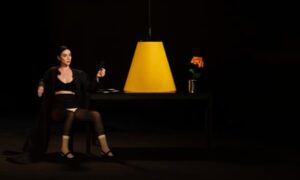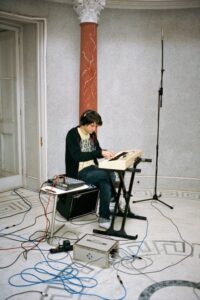The actor Elizabeth Olsen and I are in a London hotel, staring down at her dinner. She lifts the lid from one plate: a bowl of plain black beans. She lifts another: a bowl of similarly spare couscous. You wouldn’t know it, but Olsen is something of a foodie. She takes a set of knives around the world when filming, makes her own ricotta, knows what brand of caviar is best, and records the name of every restaurant she visits. She’s been engaged for years in an LA “croissant crawl” to find the best French pastry in the city, though she takes the hunt international every chance she gets. This past week she’s eaten a huge amount of red meat, she tells me, and developed high cholesterol as a result. Hence the simple grain and pulse dishes before her. Carefully she returns the lids. Then she says, “I am probably not going to eat while we talk.”
In person, Olsen, who is 35, manages the curious combination of being at once unnerving and disarming. Those wide eyes – so expressive and searching on screen – would be unsettling if it weren’t for her easy wit. It’s the eyes that Hollywood has latched on to: they have been deployed to reveal the trauma of an ex-cult member (her indie breakout Martha Marcy May Marlene), a wife in a loveless marriage driven to murder (Love & Death), a grieving widow (Sorry For Your Loss). As Wanda Maximoff, appearing in the Marvel films that have dominated her last decade, her eyes have been used to portray a virtual assault course of loss.
Olsen’s latest film is a Netflix indie, His Three Daughters, which sees her back in grief mode as Christina, one of three estranged sisters (the others are played by Natasha Lyonne and Carrie Coon) who reunite at their ailing father’s apartment to await his death. “I mean, I feel like these are the characters I’m drawn to,” Olsen says, of portraying grief-stricken women. “But this is different, right? I felt like Christina was someone soft, someone I haven’t really explored before. I usually try – especially recently – to find characters that seem adjacent but different to me.”
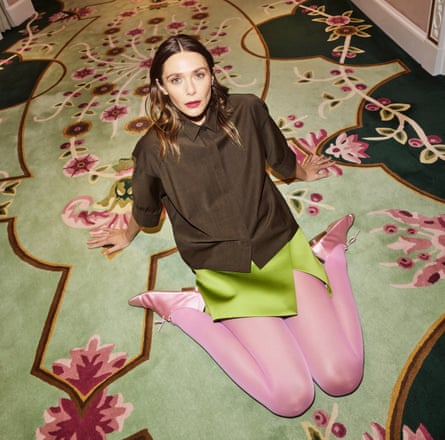
His Three Daughters can be painful to watch, particularly if you have lost someone recently. It explores how siblings often revert to childhood roles when they are together as adults. But it also makes known the terrible admin of death: the banality of being put on hold on different phones, of concluding someone’s life via paperwork, the Do Not Resuscitate form reduced to the world of the tax return.
Olsen’s Christina is the most balanced of the sisters and we see her using breathing exercises and meditation to find calm. It’s something Olsen can relate to. She suffered extreme bouts of anxiety and panic attacks in her 20s. “I’ve gone through phases of it,” she says, of using meditation. “Figuring out what works for me, or what works enough. No one talked about panic attacks in the mid-2000s. I thought it meant you just write a list and check things off and get over it. I didn’t realise it was something you had no control over, but I had to figure out how to have some control.”
Olsen has talked about this period before but not at length. At their worst she had them every day. “Multiple times, like, almost every hour!” The slightest thing would set her off. “It was literally, like, any time there was a shift in something: hot to cold, hungry to full. I thought, ‘Oh, is this OK?’ And then it would spiral and it just became this habit.” She had to “interrupt the thinking process”, she says, and would start naming all the things she saw in her head to break it. She hasn’t had them since. “You learn very quickly who you feel comfortable around and who you don’t.”
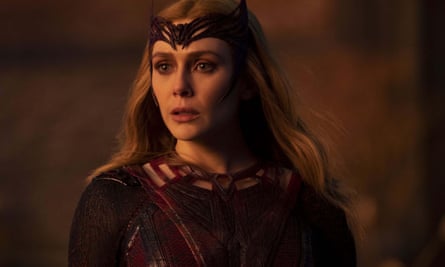
For years, though, Olsen stopped wearing heels: she realised the shoes brought on a feeling of vertigo, which in turn brought on the attacks. But heels are near-essential for actors appearing at public events like Q&As. For a while, she would wear them to walk on stage in front of an audience, before swiftly taking them off. “People thought it was a feminist choice,” she recalls. “Like, nah! If I wear them and I’m standing in front of you guys, I’m gonna panic. I’d rather have my feet on the ground.”
Olsen grew up in the LA suburb of Sherman Oaks. Her father, David, was a real-estate broker. Her mother, Jarnie, was an ex-dancer. As a child she was not a natural risk taker. Whenever she went to theme parks with friends, she would dutifully queue for rollercoasters with them, walk on to the ride and then straight off the other side, where she would wait until they were done. “I don’t like adrenaline,” she says. “I would tell my friends: if I’m on the rollercoaster, it’s gonna go wrong.” She had a nightmare recently that someone had tricked her on to one. “There was a loop,” she says gravely.
Her older sisters – twins Mary-Kate and Ashley Olsen – became childhood stars, thanks to the TV sitcom Full House. She briefly tried to follow in their footsteps. She once appeared in Full House as the character “Girl with Flowers” – a cameo. And she was hired for a nascent ad about internet safety. But she was also interested by dance. When she had to choose between acting auditions and ballet, her father advised her to write a list of the pros and cons of acting. Too many cons, she discovered. Too many ballet classes missed. Ballet it was.
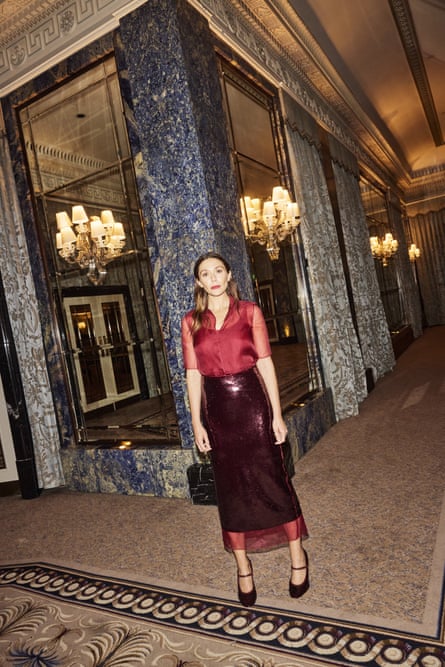
In junior high school, by her early teens, Olsen decided she wanted to be an accountant, or work on Wall Street. “I woke up one day and was like, ‘Oh, this is super embarrassing that I want to be an actor.’ And you know what? I’m really good at maths. I really understood numbers. I should probably be an accountant or investment banker. I mean, of course.”
I ask her if that was a reaction to her sisters already being famous.
“I’m sure that played into the idea of it being silly wanting to be an actor,” she says. Olsen is notoriously reticent when it comes to discussing her twin sisters, beyond saying things like it was a benefit there were two of them: if she was spoiled by one, the other wanted to match it. But on a podcast in 2021, she did allow the following. “It was weird growing up with that,” she said of the attention. “The paparazzi part… they follow you. As a child it was very scary.”
Still, by the time Olsen left high school, acting was back on the cards, but the ambition was paired with a rigorous plan to discourage any idea of nepotism. She applied to NYU’s Tisch School of the Arts, classes at the Atlantic Theatre Company,
a semester at the Moscow Art Theatre School in Russia.
“It was the academia of the thing that justified me becoming an actor,” she says. “It felt like, if I go out east and go to New York and do theatre, it was like legitimising something. I really wanted it to be a discipline. And I was a good student.”
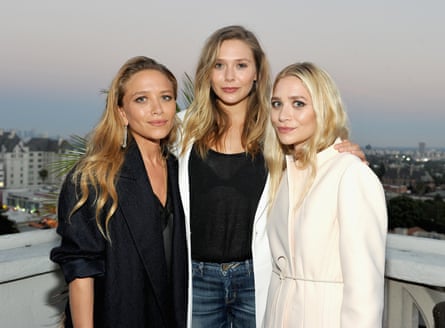
Olsen was so good, in fact, that she developed an unfortunate nickname. A teacher once told her to rehearse eight hours for a two-minute scene. Olsen decided that she – and any actors in the scene with her – should rehearse for 10 hours. She only realised that no one else did this in her third year when a guy she’d never acted with greeted her with the words, “Oh my God, you’re the rehearsal Nazi!”
Olsen landed Martha Marcy May Marlene straight out of drama school and hasn’t looked back. And yet, despite now being an Avenger and with nominations for two Golden Globes and an Emmy under her belt, she’s not entirely ruling out a more practical career shift. “I think if I ever stop being curious, I should be taking up another career,” she says, “which I’m open to.”
Like what? I ask.
“A few different things. I would love to learn more from an agricultural standpoint, I don’t exactly know what that means yet, but I get very frustrated by this small amount of soil that I can maintain. And I love construction and interior design.”
Olsen “secretly eloped” in 2019, to use the tabloid description, to marry her longtime partner, the musician Robbie Arnett. The ceremony involved just her, Arnett, a justice of the peace, and a man who did the paperwork. It sounds thrilling, I say, running away together. Yet she says the reality was more prosaic. They simply planned to get the paperwork out of the way in order to have a full-on celebration with guests later. “I thought, let’s just sign these papers, let’s not have too much attachment.”
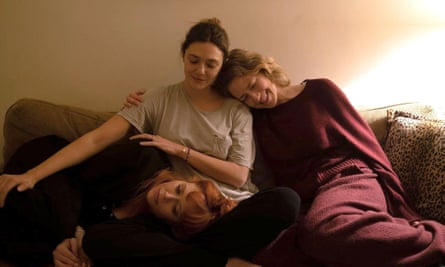
Olsen and Arnett now live in rural northern California but, ever the worrier, America’s gun violence weighs heavily on her mind. She often has dreams of being shot, she says. “I’ve died in a lot of dreams. I’ve been shot in the head and killed. And it’s like, now I have cold blood rushing down my head, and it’s darkness.” She has considered moving to the UK. She and Arnett fell in love with London when they were living in a house overlooking the Thames, while Olsen shot the 2022 Marvel film Doctor Strange in the Multiverse of Madness.
“I got in [to central London] last night,” she says, “and this morning, the immediate moment I stepped outside and had a coffee, I’m just calmed. We’re always worried about random acts of violence in the United States without even really processing that. And I know there’s violence everywhere, not everywhere is perfect, and there are certainly things to be angry about and to be scared of, but” – here’s that word again – “there’s just a calm I feel here.”
It’s not hard to see a through-line between Olsen the person – a natural worrier, prone to panic and anxiety who’s taught herself mindfulness techniques to tackle it – and what makes Olsen so compelling on screen. Her surface is usually calm and still, but you can always sense the currents beneath.
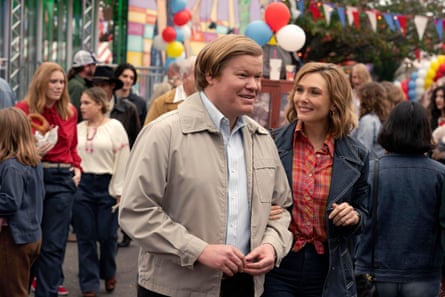
Her husband also suffers from anxiety, so the pair wrote a children’s book together about a helpful cat, Hattie Harmony: Worry Detective, to teach concerned kids how they can cope. “Me heart is racing,” says a fretful Dolphin towards the book’s end. “One of our greatest tools is something we do all the time,” advises Hattie. “We breathe.”
The first film poster Olsen ever owned, bought when she was 17, is an original Annie Hall, from its theatre release in 1977. Its star, Diane Keaton, has always been her idol. Olsen has said that Keaton made her understand “the kind of woman I wanted to be, because I hadn’t seen the woman I felt connected to in films. I was like, I’m not the sexy one, I’m not the nerd, I don’t know where I fit.” Seeing Keaton – a bit neurotic, a bit silly, nearly always opinionated – gave her a way of being to aim for.
I wonder if she still owns it.
“Yeah, it’s in my TV room!” she says. It has hung in every house she’s ever lived. “My high-school boyfriend gave it to me. I think he wrote on the back of it, but I haven’t taken it out of the frame, so I’ve no idea what he wrote. But yeah, that’s still hanging in my house. And now I also have 8½ and Chinatown. So we have [Roman] Polanski and Woody [Allen] represented, which is, you know, probably not great…” she laughs.
“But they’re great films!” she goes on. “I mean, I’ve got a [Robert] Altman in there, too. He seems to have stood the test of time…”
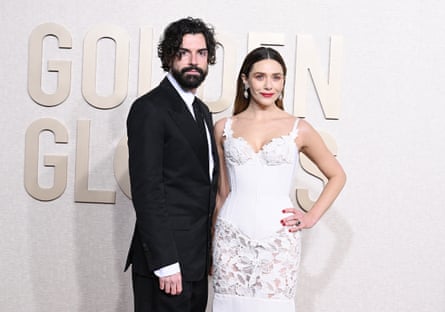
Olsen’s forthcoming roles are a throwback to the indie parts she made her name with. After His Three Daughters, she’ll star in The Assessment, a dystopian drama about a couple (Olsen and Himesh Patel) forced to live with an official (Alicia Vikander) who decides whether or not they’re allowed to have children. After that, she’ll star in Eternity, alongside Miles Teller and Callum Turner, which is a romcom set in the afterlife. (“It’s very Albert Brooks, Billy Wilder… It’s very much not a modern-day, hip cultural romcom.”)
The past decade has been a busy period for the Olsen. One piece of advice her famous twin sisters gave her early on was: “No is a full sentence.” Meaning: don’t shy away from being assertive, especially as a woman in Hollywood.
Does she think she sticks to it?
“Oh gosh, I say no to lots of things. It’s when I don’t that I sometimes get upset with the outcome. You know, because I was being too much of a people pleaser, because that’s a habit of mine.” But more and more, she says, she’s modified it. “There’s a way to disagree with something while having a suggestion for something else. It’s kind of the rule of improv, right? You want to say, ‘Yes… and…’ And that’s in life as in work, I think. In everything.”
A few weeks ago, in New York, Olsen was doing press for His Three Daughters. The cast had to travel from interviews to a screening, which was a three-hour drive away, but needed to get there quicker. So a helicopter was arranged, spiriting Olsen, co-star Natasha Lyonne, writer-director Azazel Jacobs and others across the Manhattan skyline.
For someone who has nightmares about rollercoasters, this was not ideal. “It was my first time in a helicopter,” she says, dead seriously, still clearly traumatised by the memory. “I hated it so much. It was like being on a rollercoaster for an hour and a half, even though it was probably 45 minutes. It was brutal. It wasn’t for me. I just thought about dying the whole time.”
But when I speak to Jacobs later, he remembers it rather differently. While he, too, felt he was flying in a “metal coffin”, he put a brave face on it and took pictures. Yet as he watched Lyonne “bouncing all around and just seeming not to notice”, he says he barely noticed Olsen’s turmoil. “I just remember her being very calm about it. You could see her centring herself. She just stayed in the same position. And for 40 minutes, she was perfectly, perfectly still.”
Olsen will definitely say “no” to a helicopter ride next time, she tells me. And “no” will be a complete sentence. “I’ll never do it again,” she says. And she grins
His Three Daughters is available to stream on Netflix now
Fashion editor Helen Seamons; makeup by Mary Wiles using Lisa Eldridge Beauty at Walter Schupfer Management; hair by Daniel Martin using Oribe; fashion assistant Sam Deaman; photography assistants Nick Graham and Scott Hobson-Jones
Source: theguardian.com














